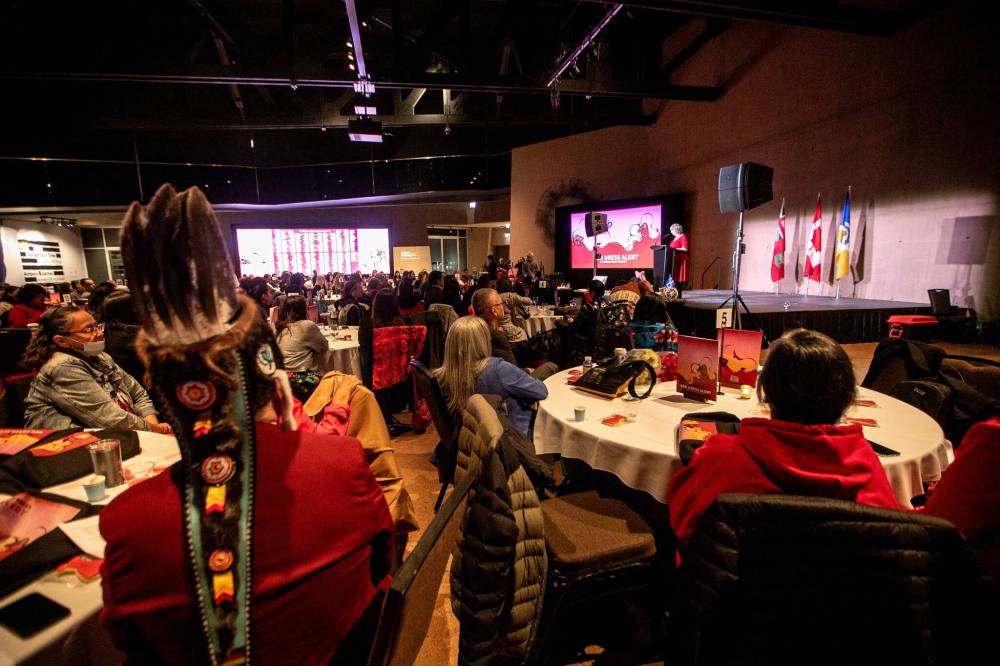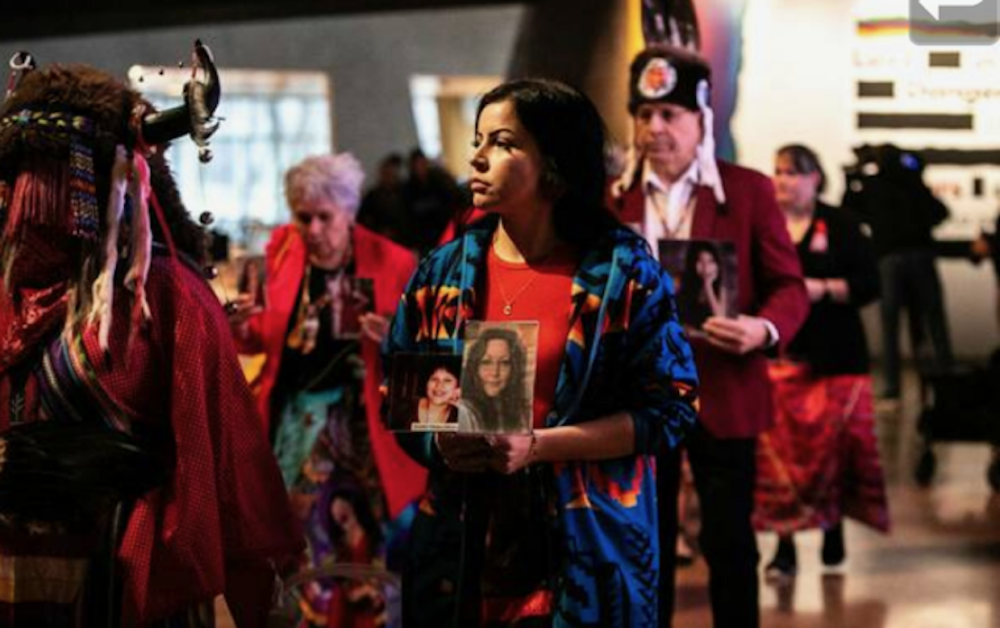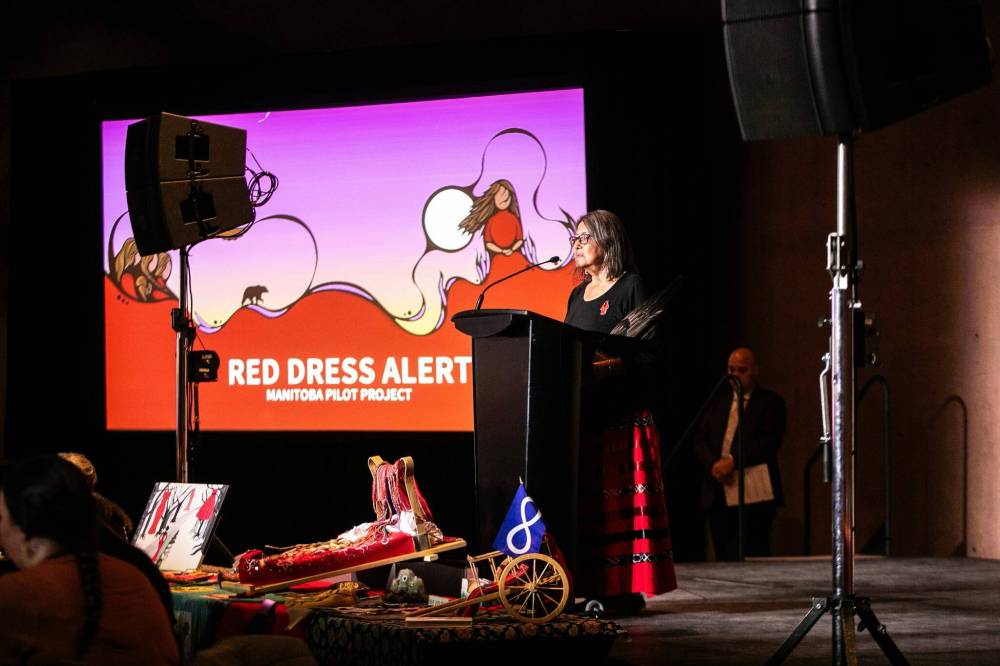Indigenous organization’s report moves Red Dress Alert one step closer in Manitoba
Advertisement
Read this article for free:
or
Already have an account? Log in here »
To continue reading, please subscribe:
Monthly Digital Subscription
$0 for the first 4 weeks*
- Enjoy unlimited reading on winnipegfreepress.com
- Read the E-Edition, our digital replica newspaper
- Access News Break, our award-winning app
- Play interactive puzzles
*No charge for 4 weeks then price increases to the regular rate of $19.00 plus GST every four weeks. Offer available to new and qualified returning subscribers only. Cancel any time.
Monthly Digital Subscription
$4.75/week*
- Enjoy unlimited reading on winnipegfreepress.com
- Read the E-Edition, our digital replica newspaper
- Access News Break, our award-winning app
- Play interactive puzzles
*Billed as $19 plus GST every four weeks. Cancel any time.
To continue reading, please subscribe:
Add Free Press access to your Brandon Sun subscription for only an additional
$1 for the first 4 weeks*
*Your next subscription payment will increase by $1.00 and you will be charged $16.99 plus GST for four weeks. After four weeks, your payment will increase to $23.99 plus GST every four weeks.
Read unlimited articles for free today:
or
Already have an account? Log in here »
In the weeks before Tina Fontaine’s death in 2014, her great aunt, Thelma Favel, spent hours calling authorities hoping for help to find the teen, who’d disappeared into Winnipeg’s troubled streets. Too often Favel found closed doors, and officials who passed on her pleas.
“They kept hanging the phone up on Thelma, saying ‘she’s not ours, she’s not our problem,” recalled Marilyn Courchene, a longtime advocate from Sagkeeng First Nation. “She said, ‘Marilyn, I tried to get help for my Tina, but they didn’t listen.’”
In the end, Courchene said, after Tina’s body was found, it was community that lifted up her family, and community that surged together demanding justice. That groundswell eventually helped spur the 2016 National Inquiry Into Missing and Murdered Indigenous Women and Girls, and drive other key changes.

MIKAELA MACKENZIE / FREE PRESS
On Tuesday morning, Indigenous-led organization Giganawenimaanaanig released its final report exploring the need for a Manitoba-wide Red Dress Alert, a proposal for an alert whenever Indigenous women, girls and two-spirit people go missing.
“A lot of answers grew out of that little girl, Tina,” Courchene said.
Now, perhaps, there is one more answer, one that looks to harness that community strength to help bring more Indigenous women, girls, and two-spirit folks home.
On Tuesday morning, Indigenous-led organization Giganawenimaanaanig released its final report exploring the need for a Manitoba-wide Red Dress Alert. The proposed new alert would spring into action when Indigenous women, girls and two-spirit people go missing, uniting families, communities and police in the crucial first hours and days.
The report, funded by the federal government, comes after nearly a year of consultation with families of victims, survivors of violence and members of impacted communities. The framework it proposes is rooted in their experiences, creating a vision that is guided by Indigenous culture and which seeks to bridge longstanding rifts between communities and police.
“We had a feeling from community members and family that, let’s move quickly, because our families and relatives need this in place now,” project chair Sandra DeLaronde said, speaking after a ceremony at the Canadian Museum for Human Rights. “Now it’s about putting it on the ground and making it happen.”

MIKAELA MACKENZIE / FREE PRESS
Corley McPherson holds photos of her aunt Jennifer McPherson, left, and great aunt Jennifer Glenna Johnston. Both were murdered; Johnston in 1980 and McPherson in 2013.
Among those in attendance for the report’s release were representatives from the city, province and federal government, as well as Winnipeg Police Service Chief Gene Bowers, who voiced support for the alert, calling it “a partnership which will strengthen our capacity to serve our Indigenous communities and help us live up to” the national inquiry’s 231 calls for justice.
On a long table near the edge of the hall, photos of some of Manitoba’s missing and murdered Indigenous women, girls and two-spirit people stood surrounded by flowers and candles. It was a heart-wrenching reminder of the stakes: with every year that passes, those images are joined by more portraits, and more names.
To develop the report, Giganawenimaanaanig — “We All Take Care of Them” in Anishinaabemowin — held 43 community engagement sessions between January and October, many of them in impacted Indigenous communities across Manitoba. They began in Sagkeeng, about 120 kilometres north of Winnipeg, which has one of the highest rates of MMIWG2S.
“What we need in this time and place is for everyone, all peoples to come together and care for one another, and make sure we don’t see another Indigenous person gone missing and murdered again,” said Sagkeeng First Nation Chief E.J. Fontaine, speaking at the report’s release.
“I know it’s a vision that we have in our community, and… this initiative to have alerts and supports available for women is going to go a long ways to helping women feel safe, feel protected and feel loved, because that’s what we need, is women to feel loved once again.”
Much of what Giganawenimaanaanig heard during those consultations dealt with a rift of trust between Indigenous people and police. Yet their consultation also showed where impacted communities are open to healing those rifts with authorities, as they look to work together make their communities safer.

MIKAELA MACKENZIE / FREE PRESS
Thelma Morrisseau speaks at the Red Dress Alert report release event on Tuesday.
For example, in an online survey of 1,000 people, just under six per cent thought police alone should determine when a Red Dress Alert is issued. Yet nearly two-thirds believed the decision should be made by a team that includes relatives, survivors and police, over options that include a team of only Indigenous staff, or a team of relatives and survivors.
Overall, families made clear, the Red Dress Alert should allow authorities, communities and families to co-ordinate and get information out in a clear and timely fashion. Above all, Giganawenimaanaanig heard, those alerts must include culturally informed supports for families, as they face the scary and stressful search for a loved one.
“We can get an alert. It’s about pressing a button, right? Sending an alert out,” DeLaronde said. “So it’s more about being able to support individuals on the ground before an alert is necessary. And I think that’s really the challenge.”
The next step, DeLaronde said, is for the province to sign on. In order to have sufficient resources and impact, the proposed alert will need to have companion legislation. With that legislation in hand, DeLaronde said, Giganawenimaanaanig expects to begin work on establishing the alert system in January, and have it fully operational by June.
Speaking to reporters at the legislature Tuesday, Premier Wab Kinew signalled his government was open to the idea.
“We’ve definitely been hearing from the group organizing the Red Dress Alert in the leadup to this,” Kinew said. “We’ve been supportive and communicating with them. The big thing is, let’s just make everyone safer in Manitoba. We’ve seen some terrible stories, very high-profile ones. And if this can help make women, girls, two-spirit people safer, let’s pursue it.”

MIKAELA MACKENZIE / FREE PRESS
Sagkeeng elder Mary Starr takes a look at photos of some of Manitoba’s missing and murdered Indigenous women, girls and two-spirit people at the Red Dress Alert report release event on Tuesday.
He deferred to cabinet members Bernadette Smith and Nahanni Fontaine for further comment.
— With files from Carol Sanders
melissa.martin@freepress.mb.ca

Melissa Martin
Reporter-at-large
Melissa Martin reports and opines for the Winnipeg Free Press.
Every piece of reporting Melissa produces is reviewed by an editing team before it is posted online or published in print — part of the Free Press‘s tradition, since 1872, of producing reliable independent journalism. Read more about Free Press’s history and mandate, and learn how our newsroom operates.
Our newsroom depends on a growing audience of readers to power our journalism. If you are not a paid reader, please consider becoming a subscriber.
Our newsroom depends on its audience of readers to power our journalism. Thank you for your support.
History
Updated on Wednesday, November 26, 2025 6:20 AM CST: Adds to phoro cutline, rearranges photos


